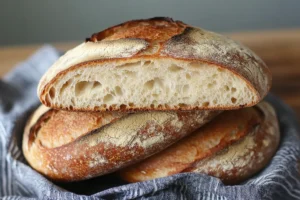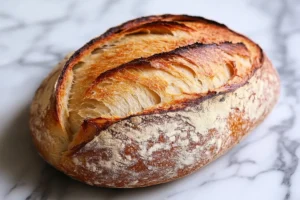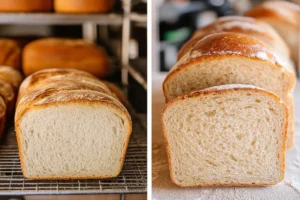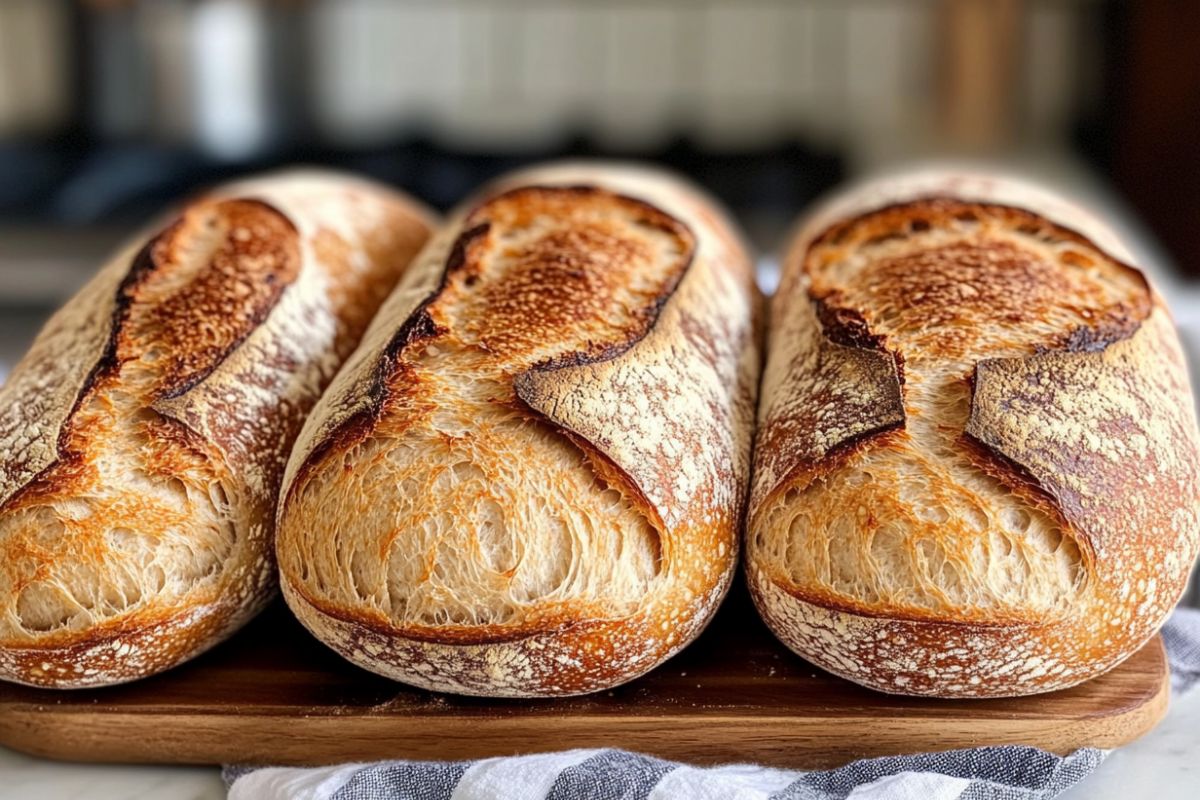Sourdough bread has grown in popularity among home bakers for its tangy flavor and unique texture. One key element in the baking process is scoring, which allows the bread to rise and expand properly during baking. While scoring is essential for many types of bread, you may wonder, “Do you score sourdough sandwich bread?” The answer can vary depending on your desired texture and baking technique.
In this comprehensive guide, we’ll dive into the reasons for scoring sourdough sandwich bread, the techniques to use, and when it may not be necessary. You’ll also learn how to avoid common mistakes and get answers to frequently asked questions about scoring sandwich bread.
What Is Scoring in Bread Baking?
Scoring is the process of making cuts or slashes on the surface of dough before baking. These cuts allow the bread to expand in a controlled manner during oven spring (the rapid rise that occurs during the first few minutes of baking). This helps prevent the bread from tearing or bursting as it bakes.
- Purpose of scoring: It directs the expansion of the bread to ensure a uniform shape and prevents cracks in unwanted areas.
- Scoring for aesthetics: While scoring is functional, it also allows bakers to add decorative patterns to their loaves, creating visually appealing results.
To better understand the importance of scoring, check out scoring sourdough bread the right way, which provides a detailed explanation of the process.
Why Do Some Bakers Score Sourdough Sandwich Bread?
Many bakers choose to score sourdough sandwich bread to guide the bread’s rise and expansion in the oven. Without scoring, the bread might rise unevenly, leading to tears or bulges in the crust. Scoring ensures that the expansion occurs in a controlled way, resulting in a loaf that has a consistent shape and crumb structure.
- Preventing crust tears: By creating a weak point on the surface of the dough, scoring helps avoid unsightly cracks that can occur when the bread expands too quickly.
- Enhancing oven spring: Proper scoring can enhance the oven spring of your bread, allowing it to rise evenly and develop a better crumb.
If you’re looking to achieve consistent results with your sourdough sandwich bread, mastering scoring techniques is essential. You can also learn more about tools and techniques for scoring bread to improve your baking skills.
Why Some Bakers Choose Not to Score Sourdough Sandwich Bread

While scoring has its benefits, some bakers opt not to score sourdough sandwich bread, especially when using a loaf pan. Sandwich bread tends to rise in a more controlled manner because the loaf pan provides structure and support during baking. As a result, the need for scoring is often reduced.
- Smooth crust: Skipping the scoring can result in a smoother, softer crust, which is desirable for traditional sandwich bread.
- Loaf pan structure: The pan naturally directs the dough’s rise, reducing the need for scoring to manage expansion. This creates a uniform loaf ideal for sandwiches.
If you’re aiming for a smooth top and even texture, you might consider skipping the scoring step, particularly if you’re using a loaf pan.
How to Properly Score Sourdough Sandwich Bread
If you decide to score your sourdough sandwich bread, it’s important to do it correctly to ensure an even rise and prevent the dough from deflating. Here’s a step-by-step guide on how to properly score your bread:
Tools for Scoring
To achieve the best results, you’ll need the right tools:
- Bread lame or razor blade: These tools offer the most precision for clean, sharp cuts.
- Sharp kitchen knife: If you don’t have a bread lame, a sharp knife will work as an alternative, though it may not provide the same level of precision.
Step-by-Step Guide
- Prep the dough: After your dough has proofed and is ready to bake, gently transfer it to a surface where you can make the cuts.
- Make the cut: Using your bread lame or razor blade, make a single, deep slash along the top of the dough. The cut should be at least ¼ inch deep to allow the bread to expand properly.
- Choose your scoring pattern: The most common pattern for sandwich bread is a simple straight slash down the center, but you can also experiment with other designs, such as diagonal or decorative cuts.
- Bake immediately: After scoring, bake your bread right away to prevent over-proofing or collapsing.
Common Mistakes to Avoid
- Too deep of a score: This can cause the bread to collapse during baking.
- Too shallow of a score: Shallow cuts may not open up enough during baking, leading to uneven expansion.
Variations in Scoring Patterns for Sandwich Bread
While a simple, single score down the center is most common for sourdough sandwich bread, you can experiment with different scoring patterns to create both functional and decorative effects.
- Single center slash: This straightforward score is ideal for guiding the rise of sandwich bread without adding unnecessary complexity.
- Diagonal scores: A series of diagonal slashes can help guide the rise while adding a bit of visual interest.
- Decorative scoring: For those who enjoy making their bread more visually appealing, decorative scoring techniques like cross-hatching or curved lines can be used, though they are more commonly seen in artisan loaves.
The scoring method you choose can influence both the texture and appearance of your finished loaf. For sandwich bread, simpler scoring methods tend to work best.
Should You Score Every Type of Sourdough Sandwich Bread?
Not all types of sourdough sandwich bread require scoring, and whether or not you should score depends largely on the type of dough and the texture you’re aiming to achieve. Let’s take a closer look at the different types of sourdough bread and the factors to consider when deciding whether to score.
White Flour Sourdough
White flour sourdough is often the most common choice for bakers making sandwich bread. This type of dough is typically lighter and has a higher potential for expansion in the oven, meaning it benefits from scoring to control the rise. If you don’t score, you may experience random cracks or splits as the dough tries to expand.
- Why score: Scoring white flour sourdough helps guide the expansion of the dough, leading to a more uniform loaf.
- When to skip scoring: If you want a very smooth top crust and are using a loaf pan, you might decide to skip scoring. However, be aware that skipping the score could lead to uneven expansion.
Whole Wheat and Multigrain Sourdough
Whole wheat and multigrain sourdough breads are generally denser than their white flour counterparts. Because these doughs contain more fiber and less gluten, they don’t experience the same dramatic oven spring. As a result, scoring is often less critical for these types of breads.
- When to score: If you want to encourage a little more oven spring or ensure the loaf opens up evenly, a light score down the middle can help.
- When to skip scoring: Whole wheat and multigrain breads often don’t need to be scored, especially if you’re aiming for a soft, smooth top.
Enriched Sourdough Doughs
Enriched doughs, such as those made with added fats like butter, milk, or eggs, have a more tender crumb and a less aggressive rise. These types of doughs tend to have a natural limit on how much they expand in the oven, so scoring isn’t always necessary. Popular enriched doughs like brioche or milk bread are typically left unscored to maintain a soft, smooth top.
- When to score: If you’re working with a higher hydration enriched dough that still has a lot of oven spring, you can opt for a shallow score to guide the rise.
- When to skip scoring: For doughs with added fat or dairy, such as brioche, scoring is often unnecessary because the enriched doughs rise in a more controlled and gentle way.
High-Hydration Sourdough
High-hydration sourdough doughs, with water content above 70%, tend to expand rapidly in the oven, creating large, airy holes. Scoring high-hydration sourdough sandwich bread is usually recommended to prevent random cracking and ensure a consistent crumb structure.
- Why score: High-hydration doughs benefit from a deeper score to guide the rapid rise that occurs during baking.
- When to skip scoring: In very rare cases, if the dough is extremely hydrated and in a loaf pan, you might not need to score. However, most high-hydration doughs require scoring to avoid bursting.
Factors That Influence Whether You Should Score

- Hydration level: Higher hydration doughs need scoring to control the rapid oven spring. Lower hydration doughs can sometimes be baked without scoring, especially when using a loaf pan.
- Baking method: Free-form loaves often require scoring to guide the rise. Loaf pans help shape the dough, reducing the need for scoring.
- Desired crust texture: If you want a soft, smooth crust (typical for sandwich bread), skipping the score may be preferable. For a more rustic appearance and controlled expansion, scoring is beneficial.
Whether or not you should score your sourdough sandwich bread depends on the type of dough, your desired outcome, and the baking method you’re using. While scoring can help guide the expansion and ensure a uniform rise, it isn’t always necessary, particularly for denser or enriched doughs that naturally expand less. For lighter doughs, especially those with high hydration, scoring is essential to prevent cracks and encourage even oven spring.
FAQs About Scoring Sourdough Sandwich Bread
Do You Need to Score Sourdough Sandwich Bread in a Loaf Pan?
Scoring sourdough sandwich bread when baking in a loaf pan is optional. The pan helps shape the dough and provides structure during the rise, so scoring may not be necessary. However, scoring can still help guide the expansion of the dough, especially if you want to avoid any cracking or tearing on the sides.
What Happens If You Don’t Score Sourdough Bread?
If you skip scoring, the bread may expand unevenly, causing cracks or tears on the sides or top. While these cracks don’t affect the taste, they can lead to an inconsistent texture and a less attractive appearance.
Can I Score Sandwich Bread with a Kitchen Knife?
Yes, you can use a sharp kitchen knife to score sandwich bread if you don’t have a bread lame or razor blade. While a knife won’t be as precise, it can still create a functional score. Just make sure it’s sharp enough to cut through the dough cleanly.
Why Is My Sandwich Loaf Tearing on the Side?
Tearing often occurs when the dough expands too quickly in the oven. If your loaf is tearing on the sides, it may be because the score wasn’t deep enough or wasn’t positioned correctly. Proper scoring can help release the pressure and allow the bread to rise evenly.
Can I Make Decorative Scores on Sandwich Bread?
Yes! Although decorative scoring is more commonly seen on rustic or artisan loaves, you can still add artistic scores to sourdough sandwich bread for a personal touch. Keep in mind that more intricate designs might not always show up as clearly on sandwich bread due to its softer crust.

Conclusion
In the end, whether you decide to score sourdough sandwich bread depends on your baking goals. If you’re looking for a loaf with a smooth, even top, you may opt not to score. However, if you want to guide the expansion of the dough and avoid crust tears, scoring is a helpful tool.
Remember that practice makes perfect, and experimenting with different scoring patterns can help you achieve the texture and appearance you’re aiming for. Whether you’re using a loaf pan or baking a free-form loaf, mastering the art of scoring can make a significant difference in the final result of your sourdough sandwich bread.

